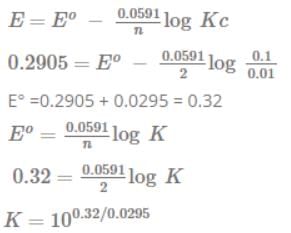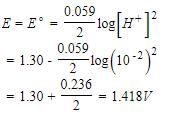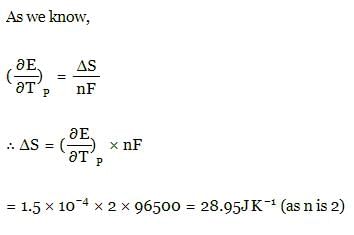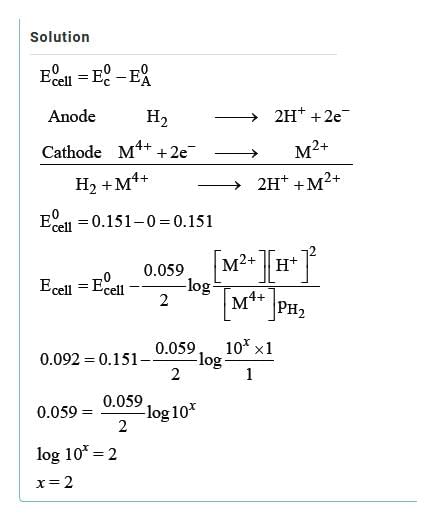All Exams >
MCAT >
MCAT Chemical and Physical Foundations >
All Questions
All questions of Electrochemistry (GC) for MCAT Exam
The cell potential for the following electrochemical system at 25°C is:Al(s) | Al3+ (0.01 M) || Fe2+ (0.1 M) | Fe (s)Given: Standard reduction potential of Al3+ + 3e– → Al is –1.66 V at 25°C
Standard reduction potential of Fe2+ + 2e– → Fe is –0.44 V at 25°C- a)1.23 V
- b)1.21 V
- c)1.22 V
- d)–2.10 V
Correct answer is option 'A'. Can you explain this answer?
The cell potential for the following electrochemical system at 25°C is:
Al(s) | Al3+ (0.01 M) || Fe2+ (0.1 M) | Fe (s)
Given: Standard reduction potential of Al3+ + 3e– → Al is –1.66 V at 25°C
Standard reduction potential of Fe2+ + 2e– → Fe is –0.44 V at 25°C
Standard reduction potential of Fe2+ + 2e– → Fe is –0.44 V at 25°C
a)
1.23 V
b)
1.21 V
c)
1.22 V
d)
–2.10 V

|
Raksha Pillai answered |
Solution:
The cell potential (Ecell) of an electrochemical cell is given by the difference between the standard reduction potentials of the half-cells.
Ecell = E°(reduction at cathode) - E°(reduction at anode)
Given: E°(Al3+ + 3e- → Al) = 1.66 V
E°(Fe2+ + 2e- → Fe) = 0.44 V
We need to determine the cell potential for the following electrochemical system at 25C:
Al(s) | Al3+ (0.01 M) || Fe2+ (0.1 M) | Fe(s)
The cell diagram represents the two half-cells in the electrochemical cell. The two vertical lines represent the phase boundary between the two half-cells, and the double vertical line represents the salt bridge.
The half-cell reactions for the given electrochemical system are:
Al3+ + 3e- → Al (reduction at cathode)
Fe2+ → Fe + 2e- (oxidation at anode)
Step 1: Write the balanced cell reaction:
Al(s) + Fe2+ (0.1 M) → Al3+ (0.01 M) + Fe(s)
Step 2: Determine the reduction potential for the cathode:
E°(Al3+ + 3e- → Al) = 1.66 V
Step 3: Determine the oxidation potential for the anode:
E°(Fe2+ → Fe + 2e-) = -0.44 V (Note: The oxidation potential is the negative of the reduction potential.)
Step 4: Calculate the cell potential:
Ecell = E°(reduction at cathode) - E°(reduction at anode)
Ecell = 1.66 V - (-0.44 V)
Ecell = 2.10 V
However, this value is incorrect as the reduction potential for iron in the given electrochemical system is not standard. We need to use the Nernst equation to calculate the actual cell potential.
Step 5: Calculate the actual cell potential using the Nernst equation:
Ecell = E° - (RT/nF) ln(Q)
where,
E° = standard cell potential
R = gas constant = 8.314 J/mol K
T = temperature in Kelvin
n = number of electrons transferred
F = Faraday constant = 96,485 C/mol
Q = reaction quotient
At equilibrium, Q = K, the equilibrium constant.
K = [Al3+] / [Fe2+]
At 25°C, the equilibrium constant for the reaction is:
K = [Al3+] / [Fe2+]
K = (0.01 M) / (0.1 M)
K = 0.1
Substituting the values in the Nernst equation:
Ecell = E° - (RT/nF) ln(Q)
Ecell = 1.66 V - (0.0257 V) ln(0.1)
Ecell = 1.23 V
Therefore, the cell potential for the given electrochemical system at 25°C is 1.23 V.
Answer: Option (a) 1.23 V.
The cell potential (Ecell) of an electrochemical cell is given by the difference between the standard reduction potentials of the half-cells.
Ecell = E°(reduction at cathode) - E°(reduction at anode)
Given: E°(Al3+ + 3e- → Al) = 1.66 V
E°(Fe2+ + 2e- → Fe) = 0.44 V
We need to determine the cell potential for the following electrochemical system at 25C:
Al(s) | Al3+ (0.01 M) || Fe2+ (0.1 M) | Fe(s)
The cell diagram represents the two half-cells in the electrochemical cell. The two vertical lines represent the phase boundary between the two half-cells, and the double vertical line represents the salt bridge.
The half-cell reactions for the given electrochemical system are:
Al3+ + 3e- → Al (reduction at cathode)
Fe2+ → Fe + 2e- (oxidation at anode)
Step 1: Write the balanced cell reaction:
Al(s) + Fe2+ (0.1 M) → Al3+ (0.01 M) + Fe(s)
Step 2: Determine the reduction potential for the cathode:
E°(Al3+ + 3e- → Al) = 1.66 V
Step 3: Determine the oxidation potential for the anode:
E°(Fe2+ → Fe + 2e-) = -0.44 V (Note: The oxidation potential is the negative of the reduction potential.)
Step 4: Calculate the cell potential:
Ecell = E°(reduction at cathode) - E°(reduction at anode)
Ecell = 1.66 V - (-0.44 V)
Ecell = 2.10 V
However, this value is incorrect as the reduction potential for iron in the given electrochemical system is not standard. We need to use the Nernst equation to calculate the actual cell potential.
Step 5: Calculate the actual cell potential using the Nernst equation:
Ecell = E° - (RT/nF) ln(Q)
where,
E° = standard cell potential
R = gas constant = 8.314 J/mol K
T = temperature in Kelvin
n = number of electrons transferred
F = Faraday constant = 96,485 C/mol
Q = reaction quotient
At equilibrium, Q = K, the equilibrium constant.
K = [Al3+] / [Fe2+]
At 25°C, the equilibrium constant for the reaction is:
K = [Al3+] / [Fe2+]
K = (0.01 M) / (0.1 M)
K = 0.1
Substituting the values in the Nernst equation:
Ecell = E° - (RT/nF) ln(Q)
Ecell = 1.66 V - (0.0257 V) ln(0.1)
Ecell = 1.23 V
Therefore, the cell potential for the given electrochemical system at 25°C is 1.23 V.
Answer: Option (a) 1.23 V.
The standard reduction potential at 298 K for the following half cells are given: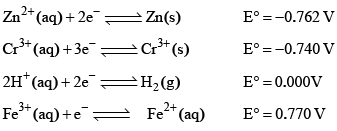 Which is the strongest reducing agent:
Which is the strongest reducing agent:- a)Zn(s)
- b)Cr(s)
- c)H2(g)
- d)Fe2+ (aq)
Correct answer is option 'A'. Can you explain this answer?
The standard reduction potential at 298 K for the following half cells are given:
Which is the strongest reducing agent:
a)
Zn(s)
b)
Cr(s)
c)
H2(g)
d)
Fe2+ (aq)
|
|
Pooja Choudhury answered |
Zn has minimum reduction potential it means Zn is strong reducing agent. Hence A is correct.
An electrochemical cell consists of two half-cell reactions. The mass of copper (in grams) dissolved on passing 0.5 A current for 1h is [Given, atomic mass of Cu is 63.6, F = 96500 C mol–1]
The mass of copper (in grams) dissolved on passing 0.5 A current for 1h is [Given, atomic mass of Cu is 63.6, F = 96500 C mol–1]- a)0.88
- b)1.18
- c)0.29
- d)0.59
Correct answer is option 'D'. Can you explain this answer?
An electrochemical cell consists of two half-cell reactions.
The mass of copper (in grams) dissolved on passing 0.5 A current for 1h is [Given, atomic mass of Cu is 63.6, F = 96500 C mol–1]
a)
0.88
b)
1.18
c)
0.29
d)
0.59

|
Veda Institute answered |
m/E = Q/F
m/(63.6/2) = (0.5 x 60 x 60)/96500
m = (1800 x 63.6)/(96500 x 2)
m = 0.59
m/(63.6/2) = (0.5 x 60 x 60)/96500
m = (1800 x 63.6)/(96500 x 2)
m = 0.59
The standard reduction potentials E°, for the half reactions are as: The emf for the cell reaction,
The emf for the cell reaction,
- a)–0.35 V
- b)+0.35 V
- c)+1.17 V
- d)–1.17 V
Correct answer is option 'B'. Can you explain this answer?
The standard reduction potentials E°, for the half reactions are as:
The emf for the cell reaction,
a)
–0.35 V
b)
+0.35 V
c)
+1.17 V
d)
–1.17 V

|
Asf Institute answered |
Fe2++2e−⟶Fe; 20mmE∘=−0.41V
20mm Zn⟶Zn2++2e−; E∘=+0.76V
⇒Fe2++Zn⟶Zn2++Fe; E∘=+0.35V
20mm Zn⟶Zn2++2e−; E∘=+0.76V
⇒Fe2++Zn⟶Zn2++Fe; E∘=+0.35V
Salts of A (atomic weight 7), B (atomic weight 27) and C (atomic weight 48) were electrolyzed under identical condition using the same quantity of electricity. It was found that when 2.1 g of A was deposited, the weights of B and C deposited were 2.7 g. The valencies of A, B and C respectively:- a)3, 1 and 2
- b)1, 3 and 2
- c)3, 1 and 3
- d)2, 3 and 2
Correct answer is option 'B'. Can you explain this answer?
Salts of A (atomic weight 7), B (atomic weight 27) and C (atomic weight 48) were electrolyzed under identical condition using the same quantity of electricity. It was found that when 2.1 g of A was deposited, the weights of B and C deposited were 2.7 g. The valencies of A, B and C respectively:
a)
3, 1 and 2
b)
1, 3 and 2
c)
3, 1 and 3
d)
2, 3 and 2
|
|
Pooja Choudhury answered |
According to faraday's law:
W = ZQ = EQ/96500
For A:
2.1=(7/x)Q/96500
For B:
2.7=(27/y)Q/96500
For C:
7.2=(48/z)Q/96500
x: y:z ::(7/2.1):(27/2.7):(48/7.2)
W = ZQ = EQ/96500
For A:
2.1=(7/x)Q/96500
For B:
2.7=(27/y)Q/96500
For C:
7.2=(48/z)Q/96500
x: y:z ::(7/2.1):(27/2.7):(48/7.2)
= 3.33:10:6.66
=1:3:2
by solving these equations,
x=1, y=3, z=2
by solving these equations,
x=1, y=3, z=2
Galvanization is applying a coating of:- a)Pb
- b)Cr
- c)Cu
- d)Zn
Correct answer is option 'D'. Can you explain this answer?
Galvanization is applying a coating of:
a)
Pb
b)
Cr
c)
Cu
d)
Zn

|
Akash Kulkarni answered |
Galvanization is the process of coating a metal object with a layer of zinc to protect it from corrosion. The correct answer is option 'D' which is Zinc.
Zinc as a coating material:
Zinc is a highly reactive metal and has a strong affinity towards oxygen. When exposed to air, it reacts with oxygen to form a thin layer of zinc oxide on its surface. This layer acts as a barrier between the metal and the air, preventing further oxidation. Zinc is also very ductile and can be easily shaped and molded to fit any object. These properties make it an ideal coating material for metal objects.
Galvanization process:
The galvanization process involves coating a metal object with a layer of zinc to protect it from corrosion. The process can be carried out using one of two methods: hot-dip galvanizing or electroplating.
Hot-dip galvanizing:
In hot-dip galvanizing, the metal object is first cleaned and then dipped into a bath of molten zinc. The high temperature of the zinc bath causes the zinc to react with the surface of the metal, forming a layer of zinc-iron alloy. The object is then removed from the bath and allowed to cool, forming a layer of pure zinc on its surface.
Electroplating:
In electroplating, the metal object is first cleaned and then placed in a solution containing zinc ions. A direct current is then passed through the solution, causing the zinc ions to be deposited onto the surface of the metal object. The object is then removed from the solution and rinsed to remove any excess zinc.
Advantages of galvanization:
Galvanization provides several benefits, including:
1. Corrosion resistance: Zinc is a highly corrosion-resistant material that protects the underlying metal from rust and other forms of corrosion.
2. Longevity: Galvanized objects have a long lifespan and can last for decades without needing to be replaced.
3. Low maintenance: Galvanized objects require very little maintenance, making them a cost-effective choice for many applications.
Conclusion:
In conclusion, galvanization is the process of coating a metal object with a layer of zinc to protect it from corrosion. Zinc is an ideal coating material due to its high reactivity, ability to form a protective oxide layer, and ductility. Galvanization provides several benefits, including corrosion resistance, longevity, and low maintenance.
Zinc as a coating material:
Zinc is a highly reactive metal and has a strong affinity towards oxygen. When exposed to air, it reacts with oxygen to form a thin layer of zinc oxide on its surface. This layer acts as a barrier between the metal and the air, preventing further oxidation. Zinc is also very ductile and can be easily shaped and molded to fit any object. These properties make it an ideal coating material for metal objects.
Galvanization process:
The galvanization process involves coating a metal object with a layer of zinc to protect it from corrosion. The process can be carried out using one of two methods: hot-dip galvanizing or electroplating.
Hot-dip galvanizing:
In hot-dip galvanizing, the metal object is first cleaned and then dipped into a bath of molten zinc. The high temperature of the zinc bath causes the zinc to react with the surface of the metal, forming a layer of zinc-iron alloy. The object is then removed from the bath and allowed to cool, forming a layer of pure zinc on its surface.
Electroplating:
In electroplating, the metal object is first cleaned and then placed in a solution containing zinc ions. A direct current is then passed through the solution, causing the zinc ions to be deposited onto the surface of the metal object. The object is then removed from the solution and rinsed to remove any excess zinc.
Advantages of galvanization:
Galvanization provides several benefits, including:
1. Corrosion resistance: Zinc is a highly corrosion-resistant material that protects the underlying metal from rust and other forms of corrosion.
2. Longevity: Galvanized objects have a long lifespan and can last for decades without needing to be replaced.
3. Low maintenance: Galvanized objects require very little maintenance, making them a cost-effective choice for many applications.
Conclusion:
In conclusion, galvanization is the process of coating a metal object with a layer of zinc to protect it from corrosion. Zinc is an ideal coating material due to its high reactivity, ability to form a protective oxide layer, and ductility. Galvanization provides several benefits, including corrosion resistance, longevity, and low maintenance.
In the electrolytic cell, flow of electrons is from:- a)Cathode to anode in solution
- b)Cathode to anode through external supply
- c)Cathode to anode through internal supply
- d)Anode to cathode through internal supply
Correct answer is option 'C'. Can you explain this answer?
In the electrolytic cell, flow of electrons is from:
a)
Cathode to anode in solution
b)
Cathode to anode through external supply
c)
Cathode to anode through internal supply
d)
Anode to cathode through internal supply

|
Edurev.iitjam answered |
Flow of Electrons in an Electrolytic Cell
In an electrolytic cell, the flow of electrons is from: Anode to Cathode through Internal Supply
This means that option B is correct. Here's why:
In an electrolytic cell, the flow of electrons is from: Anode to Cathode through Internal Supply
This means that option B is correct. Here's why:
- Anode: This is where oxidation takes place in an electrolytic cell. During oxidation, a substance loses electrons. This means that the anode is the source of electrons.
- Cathode: This is where reduction takes place in an electrolytic cell. During reduction, a substance gains electrons, meaning that the cathode is where electrons are received.
- Flow of electrons: Since electrons are produced at the anode (through oxidation) and consumed at the cathode (through reduction), the flow of electrons is from the anode to the cathode.
- Internal supply: In an electrolytic cell, the power supply is connected to the anode and cathode, creating an electric current within the cell. This current forces the electrons to move from the anode to the cathode, hence the term "through internal supply".
In summary, in an electrolytic cell, the flow of electrons is from anode to cathode through internal supply as a result of the oxidation and reduction reactions taking place at the anode and cathode, respectively.
According to the Nernst equation, the potential of an electrode changes by 59.2 mV whenever the ratio of the oxidized and the reduced species changed by a factor of 10 at 25°C. What would be the corresponding change in the electrode potential if the experiment is carried out at 30°C:
- a)60.2 mV
- b)71.0 mV
- c)59.2 mV
- d)None of these.
Correct answer is option 'C'. Can you explain this answer?
According to the Nernst equation, the potential of an electrode changes by 59.2 mV whenever the ratio of the oxidized and the reduced species changed by a factor of 10 at 25°C. What would be the corresponding change in the electrode potential if the experiment is carried out at 30°C:
a)
60.2 mV
b)
71.0 mV
c)
59.2 mV
d)
None of these.

|
Edurev.iitjam answered |
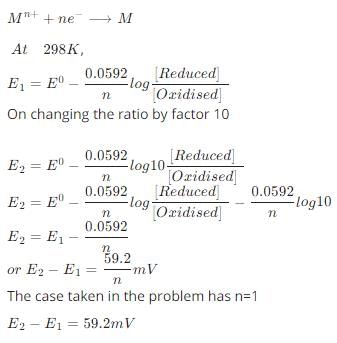
The electrochemical cell shown below is a concentration cell.
M|M2+ (saturated solut ion of a sparingly so luble salt, MX2 || M2+ (0.001 mol dm–3)| M.
The emf of the cell depends on the difference in concentration of M2+ ions at the two electrodes. The emf of the cell at 298 is 0.059 V.Q. The value of ΔG (kJ mol-1) for the given cell is (take 1 F = 96500 C mol-1)- a)–5.7
- b)5.7
- c)11.4
- d)–11.4
Correct answer is option 'D'. Can you explain this answer?
The electrochemical cell shown below is a concentration cell.
M|M2+ (saturated solut ion of a sparingly so luble salt, MX2 || M2+ (0.001 mol dm–3)| M.
The emf of the cell depends on the difference in concentration of M2+ ions at the two electrodes. The emf of the cell at 298 is 0.059 V.
M|M2+ (saturated solut ion of a sparingly so luble salt, MX2 || M2+ (0.001 mol dm–3)| M.
The emf of the cell depends on the difference in concentration of M2+ ions at the two electrodes. The emf of the cell at 298 is 0.059 V.
Q.
The value of ΔG (kJ mol-1) for the given cell is (take 1 F = 96500 C mol-1)
a)
–5.7
b)
5.7
c)
11.4
d)
–11.4
|
|
Pooja Choudhury answered |
At cathode:M+2(aq)+2e−→M(s)
At anode:M(s)+2X−(aq)→MX2(aq)+2e−
n - factor of the cell reaction is 2.
At anode:M(s)+2X−(aq)→MX2(aq)+2e−
n - factor of the cell reaction is 2.
ΔG=−nFEcell
= −2×96500×0.059
= −11.4 kJmole−1
Which statement is not correct:- a)Conductance of an electrolytic solution increases with dilution
- b)Conductance of an electrolytic solution decreases with dilution
- c)Equivalent conductivity solution decreases solution increases with dilution
- d)none
Correct answer is option 'B'. Can you explain this answer?
Which statement is not correct:
a)
Conductance of an electrolytic solution increases with dilution
b)
Conductance of an electrolytic solution decreases with dilution
c)
Equivalent conductivity solution decreases solution increases with dilution
d)
none

|
Sagarika Yadav answered |
Conductance and Equivalent Conductivity of Electrolytic Solutions
Conductance and equivalent conductivity are two important properties of electrolytic solutions. Let's understand them in detail.
Conductance of Electrolytic Solutions
Conductance is the ability of an electrolytic solution to conduct electricity. It is expressed in units of Siemens per centimeter (S/cm). The conductance of an electrolytic solution depends on various factors such as:
- The concentration of the electrolyte
- The nature of the electrolyte
- The temperature of the solution
- The area of the electrodes in the solution
Dilution and Conductance
The conductance of an electrolytic solution increases with dilution. This is because, when an electrolytic solution is diluted, the concentration of ions decreases, and the distance between the ions increases. As a result, there are more free ions that can conduct electricity, which leads to an increase in the conductance of the solution.
Therefore, option 'A' is correct.
Equivalent Conductivity of Electrolytic Solutions
Equivalent conductivity is another important property of electrolytic solutions. It is defined as the conductance of a solution containing one gram equivalent of the electrolyte between two electrodes placed one centimeter apart. It is expressed in units of Siemens per centimeter per gram equivalent (S/cm/eq).
Dilution and Equivalent Conductivity
The equivalent conductivity of an electrolytic solution decreases with dilution. This is because, when an electrolytic solution is diluted, the concentration of ions decreases, and the distance between the ions increases. As a result, the number of ions that contribute to the conductivity of the solution decreases, which leads to a decrease in the equivalent conductivity of the solution.
Therefore, option 'C' is correct.
Conclusion
In summary, the statement that is not correct is option 'B'. The conductance of an electrolytic solution increases with dilution, while the equivalent conductivity of an electrolytic solution decreases with dilution.
Conductance and equivalent conductivity are two important properties of electrolytic solutions. Let's understand them in detail.
Conductance of Electrolytic Solutions
Conductance is the ability of an electrolytic solution to conduct electricity. It is expressed in units of Siemens per centimeter (S/cm). The conductance of an electrolytic solution depends on various factors such as:
- The concentration of the electrolyte
- The nature of the electrolyte
- The temperature of the solution
- The area of the electrodes in the solution
Dilution and Conductance
The conductance of an electrolytic solution increases with dilution. This is because, when an electrolytic solution is diluted, the concentration of ions decreases, and the distance between the ions increases. As a result, there are more free ions that can conduct electricity, which leads to an increase in the conductance of the solution.
Therefore, option 'A' is correct.
Equivalent Conductivity of Electrolytic Solutions
Equivalent conductivity is another important property of electrolytic solutions. It is defined as the conductance of a solution containing one gram equivalent of the electrolyte between two electrodes placed one centimeter apart. It is expressed in units of Siemens per centimeter per gram equivalent (S/cm/eq).
Dilution and Equivalent Conductivity
The equivalent conductivity of an electrolytic solution decreases with dilution. This is because, when an electrolytic solution is diluted, the concentration of ions decreases, and the distance between the ions increases. As a result, the number of ions that contribute to the conductivity of the solution decreases, which leads to a decrease in the equivalent conductivity of the solution.
Therefore, option 'C' is correct.
Conclusion
In summary, the statement that is not correct is option 'B'. The conductance of an electrolytic solution increases with dilution, while the equivalent conductivity of an electrolytic solution decreases with dilution.
Based on the data given blow strongest oxidizing agent will be:

- a)Cl
- b)Cr3+
- c)Mn2+
- d)MnO4–
Correct answer is option 'D'. Can you explain this answer?
Based on the data given blow strongest oxidizing agent will be:
a)
Cl
b)
Cr3+
c)
Mn2+
d)
MnO4–
|
|
Pooja Choudhury answered |
As MnO4- has highest reduction potential among them so it is strongest oxidizing agent.
The solubility of a certain sparingly soluble substance MXn is nearly 1.4 × 10−4 M. If the solubility product is 1.1 × 10−11, what is the value of n?- a)1
- b)2
- c)3
- d)1.5
Correct answer is option 'B'. Can you explain this answer?
The solubility of a certain sparingly soluble substance MXn is nearly 1.4 × 10−4 M. If the solubility product is 1.1 × 10−11, what is the value of n?
a)
1
b)
2
c)
3
d)
1.5

|
Edurev.iitjam answered |
As given,
MXn → M+n + nX−

Solubility product = S × (nS)n = nnSn+1 = 1.1 × 10−11
By comparison, n = 2.
MXn → M+n + nX−

Solubility product = S × (nS)n = nnSn+1 = 1.1 × 10−11
By comparison, n = 2.
Saturated solution of KNO3 is used to make ‘salt-bridge’ because:- a)Velocity of K+ is greater than that of NO3-
- b)Velocity NO3- is greater than that of K+
- c)Velocities of both K+ and NO3- are nearly the same
- d)KNO3 is highly soluble in water
Correct answer is option 'C'. Can you explain this answer?
Saturated solution of KNO3 is used to make ‘salt-bridge’ because:
a)
Velocity of K+ is greater than that of NO3-
b)
Velocity NO3- is greater than that of K+
c)
Velocities of both K+ and NO3- are nearly the same
d)
KNO3 is highly soluble in water

|
Tanishq Goyal answered |
A homemade hand warmer. When the KNO3 is dissolved in water, it absorbs heat, making the solution cold. However, when the solution is exposed to air, the water evaporates, leaving behind solid KNO3 crystals and releasing heat. This exothermic reaction creates a heat source that can be used to warm hands or other body parts.
To make the hand warmer, you will need:
- KNO3 (potassium nitrate)
- Water
- Two sealable plastic bags (one larger and one smaller)
- A measuring cup
- A spoon
- A thermometer
Instructions:
1. Measure out 100 grams of KNO3 and pour it into the larger plastic bag.
2. Add 50 milliliters of water to the bag and seal it tightly.
3. Use your hands to mix the KNO3 and water together until the KNO3 is completely dissolved.
4. Place the bag in the refrigerator and let it chill for at least 30 minutes.
5. Once the solution is cold, remove it from the refrigerator and use the thermometer to check the temperature. It should be around 0°C (32°F).
6. Pour the solution into the smaller plastic bag and seal it tightly.
7. Place the smaller bag inside the larger bag and seal it tightly as well.
8. Massage the bags with your hands to mix the solution and activate the reaction.
9. The bags will start to warm up quickly and provide heat for up to an hour.
Caution: Potassium nitrate can be dangerous if ingested or inhaled. Use caution when handling and storing the chemicals, and do not puncture or open the plastic bags.
To make the hand warmer, you will need:
- KNO3 (potassium nitrate)
- Water
- Two sealable plastic bags (one larger and one smaller)
- A measuring cup
- A spoon
- A thermometer
Instructions:
1. Measure out 100 grams of KNO3 and pour it into the larger plastic bag.
2. Add 50 milliliters of water to the bag and seal it tightly.
3. Use your hands to mix the KNO3 and water together until the KNO3 is completely dissolved.
4. Place the bag in the refrigerator and let it chill for at least 30 minutes.
5. Once the solution is cold, remove it from the refrigerator and use the thermometer to check the temperature. It should be around 0°C (32°F).
6. Pour the solution into the smaller plastic bag and seal it tightly.
7. Place the smaller bag inside the larger bag and seal it tightly as well.
8. Massage the bags with your hands to mix the solution and activate the reaction.
9. The bags will start to warm up quickly and provide heat for up to an hour.
Caution: Potassium nitrate can be dangerous if ingested or inhaled. Use caution when handling and storing the chemicals, and do not puncture or open the plastic bags.
The molality of (NH4)2SO4 solution that has the same ionic strength as 1 mol kg–1 solution of KCl is:- a)1/3 mol kg–1
- b)1/2 mol kg–1
- c)2/5 mol kg–1
- d)3/5 mol kg–1
Correct answer is option 'A'. Can you explain this answer?
The molality of (NH4)2SO4 solution that has the same ionic strength as 1 mol kg–1 solution of KCl is:
a)
1/3 mol kg–1
b)
1/2 mol kg–1
c)
2/5 mol kg–1
d)
3/5 mol kg–1

|
Hrishikesh Verma answered |
Calculation of Ionic Strength:
Ionic strength is the measure of the concentration of ions in a solution. It is calculated using the formula:
Ionic strength (I) = 1/2 ∑ ci zi^2
Where,
ci = concentration of the ith ion
zi = charge on the ith ion
For 1 mol kg^-1 solution of KCl, the concentration of K+ and Cl- ions is 1 mol kg^-1 each. Therefore,
Ionic strength (I) = 1/2 [ (1 mol kg^-1) (1^2) + (1 mol kg^-1) (1^2) ]
I = 1 mol kg^-1
Calculation of Molality of (NH4)2SO4 solution:
To find the molality of (NH4)2SO4 solution that has the same ionic strength as 1 mol kg^-1 solution of KCl, we need to first calculate the concentration of ammonium and sulfate ions in the solution.
(NH4)2SO4 dissociates to give 2 NH4+ ions and 1 SO4^2- ion. Therefore, the total concentration of ions in the solution is:
Concentration of ions = 2[NH4+] + [SO4^2-]
Let x be the molality of (NH4)2SO4 solution. Then,
Concentration of NH4+ ions = 2x mol kg^-1
Concentration of SO4^2- ion = x mol kg^-1
Using the formula for ionic strength, we can write:
I = 1/2 [ (2x mol kg^-1) (1^2) + (x mol kg^-1) (2^2) ]
1 = 2x + 2x
x = 1/3 mol kg^-1
Therefore, the molality of (NH4)2SO4 solution that has the same ionic strength as 1 mol kg^-1 solution of KCl is 1/3 mol kg^-1.
Ionic strength is the measure of the concentration of ions in a solution. It is calculated using the formula:
Ionic strength (I) = 1/2 ∑ ci zi^2
Where,
ci = concentration of the ith ion
zi = charge on the ith ion
For 1 mol kg^-1 solution of KCl, the concentration of K+ and Cl- ions is 1 mol kg^-1 each. Therefore,
Ionic strength (I) = 1/2 [ (1 mol kg^-1) (1^2) + (1 mol kg^-1) (1^2) ]
I = 1 mol kg^-1
Calculation of Molality of (NH4)2SO4 solution:
To find the molality of (NH4)2SO4 solution that has the same ionic strength as 1 mol kg^-1 solution of KCl, we need to first calculate the concentration of ammonium and sulfate ions in the solution.
(NH4)2SO4 dissociates to give 2 NH4+ ions and 1 SO4^2- ion. Therefore, the total concentration of ions in the solution is:
Concentration of ions = 2[NH4+] + [SO4^2-]
Let x be the molality of (NH4)2SO4 solution. Then,
Concentration of NH4+ ions = 2x mol kg^-1
Concentration of SO4^2- ion = x mol kg^-1
Using the formula for ionic strength, we can write:
I = 1/2 [ (2x mol kg^-1) (1^2) + (x mol kg^-1) (2^2) ]
1 = 2x + 2x
x = 1/3 mol kg^-1
Therefore, the molality of (NH4)2SO4 solution that has the same ionic strength as 1 mol kg^-1 solution of KCl is 1/3 mol kg^-1.
FAD is a redox active molecule which takes part in many important biological reactions. the redox potential of FAD at pH 7.0 is given below: Calculate the redox potential when the media is acidified to pH0
Calculate the redox potential when the media is acidified to pH0- a)0 V
- b)0.24 V
- c)0.12 V
- d)None of these.
Correct answer is option 'B'. Can you explain this answer?
FAD is a redox active molecule which takes part in many important biological reactions. the redox potential of FAD at pH 7.0 is given below:
Calculate the redox potential when the media is acidified to pH0
a)
0 V
b)
0.24 V
c)
0.12 V
d)
None of these.
|
|
Satyabrata Sahoo answered |
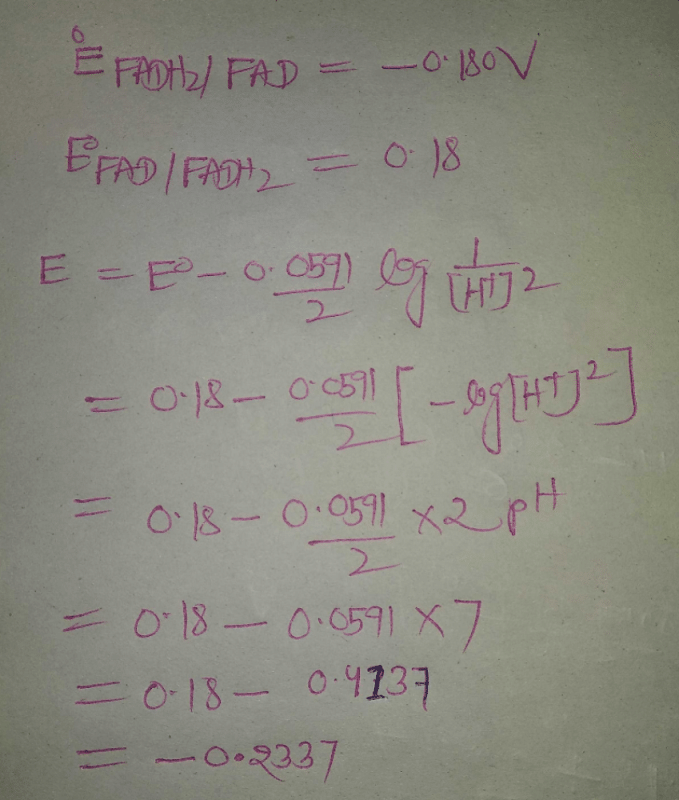
In a typical Conductometric titration of a strong acid with a weak base, the curve resembles:- a)

- b)

- c)

- d)

Correct answer is option 'B'. Can you explain this answer?
In a typical Conductometric titration of a strong acid with a weak base, the curve resembles:
a)
b)
c)
d)

|
Pie Academy answered |
Here consider a strong acid as HCL and weak base as Ammonium hydroxide that is NH4OH. Suppose the acid has high concentration of H positive ions due to which it show high conductance, when a weak base is added to it, the cation of weak base combines with Cl Negative ion to form ammonium chloride precipitate thus decreasing the conductivity by utilizing H positive ion to form water molecule due to this decrease in conductivity the graph shows on negative fall in conductance after all the edge positive and Cl negative ions are combine end point is reached where no free ions are possible for conduction after this when the basis added to form NH4 positive and was OH negative since it is a weak base it has low conductivity and the graph increases very slowly towards conduction minute changes in increasing conduction can be seen when a weak bases are added
plot a) show high conductivity which is not possible in weak bases
plot c) and d) involve 3 mixture components which is not the case
The perfect diagram would look like this and B is the closest.
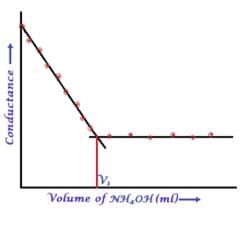
plot c) and d) involve 3 mixture components which is not the case
The perfect diagram would look like this and B is the closest.

The fraction of the total current carried by an ion is known as:
- a)Transport number of that ion
- b)Conductance of that ion
- c)Both a and b
- d)None of these.
Correct answer is option 'A'. Can you explain this answer?
The fraction of the total current carried by an ion is known as:
a)
Transport number of that ion
b)
Conductance of that ion
c)
Both a and b
d)
None of these.

|
Abhijeet Majumdar answered |
Transport number of an ion:
The transport number of an ion refers to the fraction of the total current carried by that specific ion in an electrolytic solution or a cell. It is denoted by the symbol "t" and is expressed as a decimal or fraction.
Conductance of an ion:
Conductance is a measure of an ion's ability to conduct electric current. It represents the ease with which ions move through an electrolyte solution. The conductance of an ion depends on its concentration, mobility, and charge.
Explanation:
In an electrolytic solution or a cell, multiple ions may be present. When an electric current is passed through the solution, the ions move towards the electrodes, carrying the charge. The transport number of an ion indicates the proportion of the total current that is carried by that specific ion.
The transport number of an ion can be determined experimentally using various techniques, such as the Hittorf's method or the moving boundary method. These methods allow for the measurement of changes in the concentrations of ions at the electrodes and help in calculating the transport number.
The conductance of an ion is related to its transport number. The conductance is influenced by factors such as ion concentration, ion mobility, and charge. However, it does not directly represent the fraction of total current carried by an ion.
Conclusion:
In conclusion, the fraction of the total current carried by an ion is known as the transport number of that ion. It is an important parameter in understanding the contribution of individual ions to the overall current flow in an electrolytic solution or a cell. The conductance of an ion, on the other hand, represents its ability to conduct the electric current and is influenced by various factors. Therefore, the correct answer is option 'A' - Transport number of that ion.
The transport number of an ion refers to the fraction of the total current carried by that specific ion in an electrolytic solution or a cell. It is denoted by the symbol "t" and is expressed as a decimal or fraction.
Conductance of an ion:
Conductance is a measure of an ion's ability to conduct electric current. It represents the ease with which ions move through an electrolyte solution. The conductance of an ion depends on its concentration, mobility, and charge.
Explanation:
In an electrolytic solution or a cell, multiple ions may be present. When an electric current is passed through the solution, the ions move towards the electrodes, carrying the charge. The transport number of an ion indicates the proportion of the total current that is carried by that specific ion.
The transport number of an ion can be determined experimentally using various techniques, such as the Hittorf's method or the moving boundary method. These methods allow for the measurement of changes in the concentrations of ions at the electrodes and help in calculating the transport number.
The conductance of an ion is related to its transport number. The conductance is influenced by factors such as ion concentration, ion mobility, and charge. However, it does not directly represent the fraction of total current carried by an ion.
Conclusion:
In conclusion, the fraction of the total current carried by an ion is known as the transport number of that ion. It is an important parameter in understanding the contribution of individual ions to the overall current flow in an electrolytic solution or a cell. The conductance of an ion, on the other hand, represents its ability to conduct the electric current and is influenced by various factors. Therefore, the correct answer is option 'A' - Transport number of that ion.
At 20°C, the standard EMF of a certain cell is +0.2699 V, and at 30°C it is + 0.2669 V. What can you say about the standard entropy of this reaction? Assume that the standard ΔH° and ΔS° are independent of temperature:- a)ΔS° = 0
- b)ΔS° = + ve
- c)ΔS° = -ve
- d)None of these.
Correct answer is option 'C'. Can you explain this answer?
At 20°C, the standard EMF of a certain cell is +0.2699 V, and at 30°C it is + 0.2669 V. What can you say about the standard entropy of this reaction? Assume that the standard ΔH° and ΔS° are independent of temperature:
a)
ΔS° = 0
b)
ΔS° = + ve
c)
ΔS° = -ve
d)
None of these.
|
|
Pooja Choudhury answered |
As per temperature coefficient of cell, dS= nF[dE/dT] at constant pressure Here we can se that as temp. Increase E is decrease it means if we take T as positive then E will be negative. So, here [dE/dT] this ratio will be negative which is directly proportional to the entropy change. Hence, we can say that dS= (-ve)
Which solution will conduct the electricity:
- a)Sugar in water
- b)Sugar in ethanol
- c)Iodine in ethanol
- d)MgCl2 in water
Correct answer is option 'D'. Can you explain this answer?
Which solution will conduct the electricity:
a)
Sugar in water
b)
Sugar in ethanol
c)
Iodine in ethanol
d)
MgCl2 in water

|
Sarthak Chavan answered |
**Conductivity of Solutions**
**Introduction:**
Conductivity refers to the ability of a substance to conduct electricity. In solutions, the presence of charged particles (ions) enables them to conduct electricity. Substances that dissolve in water and dissociate into ions are known as electrolytes and are conductive. On the other hand, substances that do not dissociate into ions and do not conduct electricity are called non-electrolytes.
**Explanation of Options:**
a) Sugar in Water:
Sugar (sucrose) is a covalent compound that does not dissociate into ions when dissolved in water. Therefore, it does not conduct electricity.
b) Sugar in Ethanol:
Similar to sugar in water, sugar in ethanol also does not dissociate into ions. Ethanol is a covalent compound, and therefore, the solution does not conduct electricity.
c) Iodine in Ethanol:
Iodine is a nonpolar covalent compound that does not dissociate into ions when dissolved in ethanol. Hence, the solution of iodine in ethanol does not conduct electricity.
d) MgCl2 in Water:
MgCl2 is an ionic compound composed of magnesium ions (Mg2+) and chloride ions (Cl-). When this compound is dissolved in water, it dissociates into its constituent ions. This dissociation process allows the solution to conduct electricity. The magnesium ions (Mg2+) and chloride ions (Cl-) are free to move in the solution and carry electric charge, enabling the conduction of electricity.
**Conclusion:**
Among the given options, only the solution of MgCl2 in water conducts electricity. This is because MgCl2 is an ionic compound that dissociates into ions when dissolved in water. The presence of these ions allows the solution to conduct electricity. The other options (sugar in water, sugar in ethanol, and iodine in ethanol) do not dissociate into ions and therefore do not conduct electricity.
**Introduction:**
Conductivity refers to the ability of a substance to conduct electricity. In solutions, the presence of charged particles (ions) enables them to conduct electricity. Substances that dissolve in water and dissociate into ions are known as electrolytes and are conductive. On the other hand, substances that do not dissociate into ions and do not conduct electricity are called non-electrolytes.
**Explanation of Options:**
a) Sugar in Water:
Sugar (sucrose) is a covalent compound that does not dissociate into ions when dissolved in water. Therefore, it does not conduct electricity.
b) Sugar in Ethanol:
Similar to sugar in water, sugar in ethanol also does not dissociate into ions. Ethanol is a covalent compound, and therefore, the solution does not conduct electricity.
c) Iodine in Ethanol:
Iodine is a nonpolar covalent compound that does not dissociate into ions when dissolved in ethanol. Hence, the solution of iodine in ethanol does not conduct electricity.
d) MgCl2 in Water:
MgCl2 is an ionic compound composed of magnesium ions (Mg2+) and chloride ions (Cl-). When this compound is dissolved in water, it dissociates into its constituent ions. This dissociation process allows the solution to conduct electricity. The magnesium ions (Mg2+) and chloride ions (Cl-) are free to move in the solution and carry electric charge, enabling the conduction of electricity.
**Conclusion:**
Among the given options, only the solution of MgCl2 in water conducts electricity. This is because MgCl2 is an ionic compound that dissociates into ions when dissolved in water. The presence of these ions allows the solution to conduct electricity. The other options (sugar in water, sugar in ethanol, and iodine in ethanol) do not dissociate into ions and therefore do not conduct electricity.
Which of the following conditions are satisfied when the cell reaction in the electrochemical cell is spontaneous?- a)ΔG° > 0
- b)E°cell < 0
- c)ΔG° < 0
- d)E°cell = 0
Correct answer is option 'C'. Can you explain this answer?
Which of the following conditions are satisfied when the cell reaction in the electrochemical cell is spontaneous?
a)
ΔG° > 0
b)
E°cell < 0
c)
ΔG° < 0
d)
E°cell = 0

|
Edurev.iitjam answered |
- For all spontaneous chemical reactions, the change in Gibbs free energy (ΔG°) is always negative.
- For a spontaneous reaction in an electrolytic cell, the cell potential (E°cell) should be positive.
The correct order of equivalent conductance at infinite dilution of LiCl, NaCl and KCl is:- a)LiCl > NaCl > KCl
- b)KCl > NaCl > LiCl
- c)NaCl > KCl > LiCl
- d)LiCl > KCl > NaCl
Correct answer is option 'B'. Can you explain this answer?
The correct order of equivalent conductance at infinite dilution of LiCl, NaCl and KCl is:
a)
LiCl > NaCl > KCl
b)
KCl > NaCl > LiCl
c)
NaCl > KCl > LiCl
d)
LiCl > KCl > NaCl

|
Ameya Rane answered |
> NaCl > KCl
The equivalent conductance at infinite dilution of an electrolyte depends on the size and charge of its ions. Since Li+ is the smallest ion among these three, it has the highest charge density and is more strongly solvated by the solvent molecules. This results in a lower equivalent conductance at infinite dilution for LiCl compared to NaCl and KCl. Additionally, K+ is the largest ion among these three, which makes it more difficult to move through the solvent and results in the lowest equivalent conductance at infinite dilution for KCl. Therefore, the correct order is LiCl < nacl="" />< kcl.="" />
The equivalent conductance at infinite dilution of an electrolyte depends on the size and charge of its ions. Since Li+ is the smallest ion among these three, it has the highest charge density and is more strongly solvated by the solvent molecules. This results in a lower equivalent conductance at infinite dilution for LiCl compared to NaCl and KCl. Additionally, K+ is the largest ion among these three, which makes it more difficult to move through the solvent and results in the lowest equivalent conductance at infinite dilution for KCl. Therefore, the correct order is LiCl < nacl="" />< kcl.="" />
The concentration of K+ ion inside a biological cell is 20 times higher than outside. The magnitude of potential difference between the two sides is [Given: 2.303 RT/F = 59 mV]- a)0 mV
- b)26 mV
- c)77 mV
- d)177 mV
Correct answer is option 'C'. Can you explain this answer?
The concentration of K+ ion inside a biological cell is 20 times higher than outside. The magnitude of potential difference between the two sides is [Given: 2.303 RT/F = 59 mV]
a)
0 mV
b)
26 mV
c)
77 mV
d)
177 mV
|
|
Pooja Choudhury answered |
This is a concentration cell,
Ecell=0.059log(C1/C2)
C1=20C2
Ecell=0.059log(20)
Ecell=0.0767V
=76.7mV
For the following cell,
Zn(s) | ZnSO4(aq) || CuSO4(aq) | Cu(s)
When the concentration of Zn2+ is 10 times the concentration of Cu2+, the expression for ΔG (in J mol-1) is [F is Faraday constant; R is gas constant; T is temperature; E° (cell) = 1.1 V]
- a)2.303 RT – 2.2 F
- b)2.303 RT + 1.1 F
- c)1.1 F
- d)–2.2 F
Correct answer is option 'A'. Can you explain this answer?
For the following cell,
Zn(s) | ZnSO4(aq) || CuSO4(aq) | Cu(s)
When the concentration of Zn2+ is 10 times the concentration of Cu2+, the expression for ΔG (in J mol-1) is [F is Faraday constant; R is gas constant; T is temperature; E° (cell) = 1.1 V]
a)
2.303 RT – 2.2 F
b)
2.303 RT + 1.1 F
c)
1.1 F
d)
–2.2 F
|
|
Vedika Singh answered |
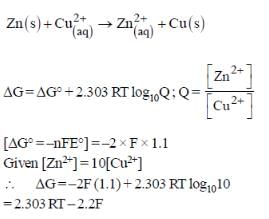
The velocity of Li+ ion in water is 2 × 10–2 cm/sec when 100 V is applied between two electrodes separated by 2 cm. The mobility of Li+ ion in water is,
- a)4 × 10–4 cm2 s–1 V–1
- b)1 × 10–4 s–1 V–1
- c)4 V cm2 s–1
- d)2.5 × 105 V s cm–2
Correct answer is option 'A'. Can you explain this answer?
The velocity of Li+ ion in water is 2 × 10–2 cm/sec when 100 V is applied between two electrodes separated by 2 cm. The mobility of Li+ ion in water is,
a)
4 × 10–4 cm2 s–1 V–1
b)
1 × 10–4 s–1 V–1
c)
4 V cm2 s–1
d)
2.5 × 105 V s cm–2

|
Edurev.iitjam answered |
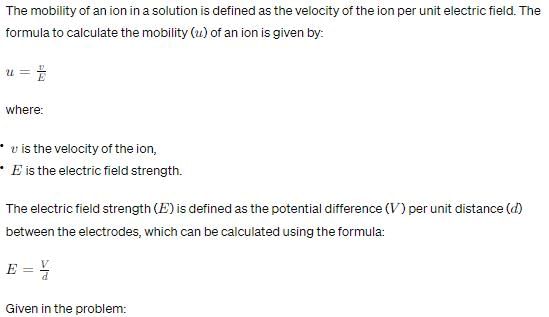
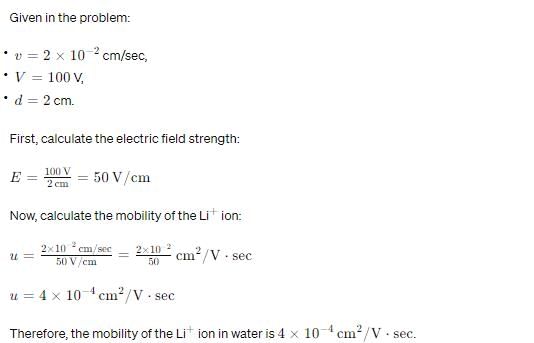
Which one of the following solutions has lowest conducting power:
- a)0.1 M CH3COOH
- b)0.1 M NaCl
- c)0.1 M KNO3
- d)0.1 M HCl
Correct answer is option 'A'. Can you explain this answer?
Which one of the following solutions has lowest conducting power:
a)
0.1 M CH3COOH
b)
0.1 M NaCl
c)
0.1 M KNO3
d)
0.1 M HCl

|
Aryan Choudhary answered |
**Answer:**
To determine the solution with the lowest conducting power, we need to consider the dissociation of the solutes in water. The greater the degree of dissociation, the higher the conducting power of the solution.
**Dissociation of the solutes:**
a) CH3COOH (acetic acid):
CH3COOH ⇌ CH3COO- + H+
b) NaCl (sodium chloride):
NaCl ⇌ Na+ + Cl-
c) KNO3 (potassium nitrate):
KNO3 ⇌ K+ + NO3-
d) HCl (hydrochloric acid):
HCl ⇌ H+ + Cl-
**Factors affecting the degree of dissociation:**
1. Nature of the solute: Strong acids and strong bases dissociate completely in water, while weak acids and weak bases dissociate to a lesser extent.
2. Concentration of the solution: Higher concentrations tend to increase the degree of dissociation.
**Explanation:**
a) 0.1 M CH3COOH (acetic acid):
Acetic acid is a weak acid and does not dissociate completely in water. It only partially ionizes into CH3COO- and H+. Therefore, the conducting power of this solution will be lower compared to the others.
b) 0.1 M NaCl (sodium chloride):
Sodium chloride is an ionic compound and dissociates completely into Na+ and Cl- ions in water. This solution will have a higher conducting power compared to acetic acid.
c) 0.1 M KNO3 (potassium nitrate):
Potassium nitrate is also an ionic compound and dissociates completely into K+ and NO3- ions in water. This solution will have a higher conducting power compared to acetic acid.
d) 0.1 M HCl (hydrochloric acid):
Hydrochloric acid is a strong acid and dissociates completely into H+ and Cl- ions in water. This solution will have a higher conducting power compared to acetic acid.
Therefore, the solution with the lowest conducting power is 0.1 M CH3COOH (acetic acid) due to its weak acid nature and partial dissociation in water.
To determine the solution with the lowest conducting power, we need to consider the dissociation of the solutes in water. The greater the degree of dissociation, the higher the conducting power of the solution.
**Dissociation of the solutes:**
a) CH3COOH (acetic acid):
CH3COOH ⇌ CH3COO- + H+
b) NaCl (sodium chloride):
NaCl ⇌ Na+ + Cl-
c) KNO3 (potassium nitrate):
KNO3 ⇌ K+ + NO3-
d) HCl (hydrochloric acid):
HCl ⇌ H+ + Cl-
**Factors affecting the degree of dissociation:**
1. Nature of the solute: Strong acids and strong bases dissociate completely in water, while weak acids and weak bases dissociate to a lesser extent.
2. Concentration of the solution: Higher concentrations tend to increase the degree of dissociation.
**Explanation:**
a) 0.1 M CH3COOH (acetic acid):
Acetic acid is a weak acid and does not dissociate completely in water. It only partially ionizes into CH3COO- and H+. Therefore, the conducting power of this solution will be lower compared to the others.
b) 0.1 M NaCl (sodium chloride):
Sodium chloride is an ionic compound and dissociates completely into Na+ and Cl- ions in water. This solution will have a higher conducting power compared to acetic acid.
c) 0.1 M KNO3 (potassium nitrate):
Potassium nitrate is also an ionic compound and dissociates completely into K+ and NO3- ions in water. This solution will have a higher conducting power compared to acetic acid.
d) 0.1 M HCl (hydrochloric acid):
Hydrochloric acid is a strong acid and dissociates completely into H+ and Cl- ions in water. This solution will have a higher conducting power compared to acetic acid.
Therefore, the solution with the lowest conducting power is 0.1 M CH3COOH (acetic acid) due to its weak acid nature and partial dissociation in water.
An electrolytic cell has three main components, an electrolyte and two electrodes (an anode and a cathode) and the electrolyte can come in two forms, either as molten or in an aqueous solution. Which of the following statements accurately describes an electrolytic cell?- a)For aqueous solutions of the electrolyte, a gas may be produced at the anode.
- b)Polyatomic ions, which are the anions of the electrolyte, are typically more easily oxidized than water.
- c)Alkali or alkaline earth metals, which are the cations of the electrolyte, do not get oxidized in an aqueous solution since water is more easily oxidized.
- d)In both molten or aqueous forms, the cation will be reduced and the anion will be oxidized.
Correct answer is option 'A'. Can you explain this answer?
An electrolytic cell has three main components, an electrolyte and two electrodes (an anode and a cathode) and the electrolyte can come in two forms, either as molten or in an aqueous solution. Which of the following statements accurately describes an electrolytic cell?
a)
For aqueous solutions of the electrolyte, a gas may be produced at the anode.
b)
Polyatomic ions, which are the anions of the electrolyte, are typically more easily oxidized than water.
c)
Alkali or alkaline earth metals, which are the cations of the electrolyte, do not get oxidized in an aqueous solution since water is more easily oxidized.
d)
In both molten or aqueous forms, the cation will be reduced and the anion will be oxidized.
|
|
Michael Hall answered |
Understanding Electrolytic Cells
Electrolytic cells are essential in electrochemistry, facilitating the conversion of electrical energy into chemical energy through redox reactions.
Statement A: Gas Production at the Anode
- In an electrolytic cell with an aqueous electrolyte, oxidation occurs at the anode.
- Commonly, water can be oxidized to produce oxygen gas, especially when the anions of the electrolyte are not easily oxidizable.
- Therefore, it is accurate to state that a gas, often oxygen, may be produced at the anode during electrolysis.
Statement B: Polyatomic Ions and Oxidation
- Polyatomic ions are not universally more easily oxidized than water.
- The ease of oxidation depends on the specific species involved.
- Water can often be oxidized more readily than certain polyatomic ions.
Statement C: Oxidation of Alkali or Alkaline Earth Metals
- Alkali and alkaline earth metals are typically present as cations in aqueous solutions.
- While water can be oxidized, in many cases, these cations are not oxidized; they are reduced instead, which contradicts the statement.
Statement D: Cation Reduction and Anion Oxidation
- This statement holds true for both molten and aqueous forms of electrolytes.
- The cation is reduced at the cathode, and the anion is oxidized at the anode, but it does not clarify the details of specific reactions.
Conclusion
- Among the options, statement A accurately describes a phenomenon commonly observed in electrolytic cells.
- Recognizing the conditions and reactions in these cells is crucial for understanding their operation and applications in electrolysis.
Electrolytic cells are essential in electrochemistry, facilitating the conversion of electrical energy into chemical energy through redox reactions.
Statement A: Gas Production at the Anode
- In an electrolytic cell with an aqueous electrolyte, oxidation occurs at the anode.
- Commonly, water can be oxidized to produce oxygen gas, especially when the anions of the electrolyte are not easily oxidizable.
- Therefore, it is accurate to state that a gas, often oxygen, may be produced at the anode during electrolysis.
Statement B: Polyatomic Ions and Oxidation
- Polyatomic ions are not universally more easily oxidized than water.
- The ease of oxidation depends on the specific species involved.
- Water can often be oxidized more readily than certain polyatomic ions.
Statement C: Oxidation of Alkali or Alkaline Earth Metals
- Alkali and alkaline earth metals are typically present as cations in aqueous solutions.
- While water can be oxidized, in many cases, these cations are not oxidized; they are reduced instead, which contradicts the statement.
Statement D: Cation Reduction and Anion Oxidation
- This statement holds true for both molten and aqueous forms of electrolytes.
- The cation is reduced at the cathode, and the anion is oxidized at the anode, but it does not clarify the details of specific reactions.
Conclusion
- Among the options, statement A accurately describes a phenomenon commonly observed in electrolytic cells.
- Recognizing the conditions and reactions in these cells is crucial for understanding their operation and applications in electrolysis.
Which ion has exceptionally higher λ∞ values:- a)H+
- b)K+
- c)NH2-
- d)OH-
Correct answer is option 'A'. Can you explain this answer?
Which ion has exceptionally higher λ∞ values:
a)
H+
b)
K+
c)
NH2-
d)
OH-

|
Akash Kulkarni answered |
Exceptionally Higher Values of H Ion
The answer to the question is option 'A' i.e. H ion has exceptionally higher values.
Explanation:
To understand why H ion has exceptionally higher values, we need to look at the concept of acidity and basicity. Acids are substances that can donate protons (H+ ions) whereas bases are substances that can accept protons. The strength of an acid or base is measured by its ability to donate or accept protons.
The acidity or basicity of a substance is measured on a scale called the pH scale which ranges from 0 to 14. A pH of 7 is neutral, a pH below 7 is acidic, and a pH above 7 is basic.
The acidity of a substance is determined by the concentration of H+ ions in the solution. The higher the concentration of H+ ions, the more acidic the solution is. Similarly, the basicity of a substance is determined by the concentration of OH- ions in the solution. The higher the concentration of OH- ions, the more basic the solution is.
Now, coming to the answer, H ion has exceptionally higher values because it is the ion that determines the acidity of a solution. When an acid is dissolved in water, it donates H+ ions to the solution, which increases the concentration of H+ ions and decreases the pH of the solution. Therefore, the higher the concentration of H+ ions, the more acidic the solution is.
On the other hand, the concentration of OH- ions in a solution is usually very low. Therefore, even a small amount of H+ ions can significantly decrease the pH of the solution, making it more acidic. This is why H ion has exceptionally higher values compared to other ions like K, NH2-, and OH-.
The answer to the question is option 'A' i.e. H ion has exceptionally higher values.
Explanation:
To understand why H ion has exceptionally higher values, we need to look at the concept of acidity and basicity. Acids are substances that can donate protons (H+ ions) whereas bases are substances that can accept protons. The strength of an acid or base is measured by its ability to donate or accept protons.
The acidity or basicity of a substance is measured on a scale called the pH scale which ranges from 0 to 14. A pH of 7 is neutral, a pH below 7 is acidic, and a pH above 7 is basic.
The acidity of a substance is determined by the concentration of H+ ions in the solution. The higher the concentration of H+ ions, the more acidic the solution is. Similarly, the basicity of a substance is determined by the concentration of OH- ions in the solution. The higher the concentration of OH- ions, the more basic the solution is.
Now, coming to the answer, H ion has exceptionally higher values because it is the ion that determines the acidity of a solution. When an acid is dissolved in water, it donates H+ ions to the solution, which increases the concentration of H+ ions and decreases the pH of the solution. Therefore, the higher the concentration of H+ ions, the more acidic the solution is.
On the other hand, the concentration of OH- ions in a solution is usually very low. Therefore, even a small amount of H+ ions can significantly decrease the pH of the solution, making it more acidic. This is why H ion has exceptionally higher values compared to other ions like K, NH2-, and OH-.
The molar conductivity of 0.009 M aqueous solution of a weak acid (HA) is 0.005 Sm2mol-1 and the limiting molar conductivity of HA is 0.005 Sm2mol-1 at 298 K. Assuming activity coefficients to be unity, the acid dissociation constant (Ka) of HA at this temperature is- a)1×10−4
- b)0.1
- c)9×10−4
- d)1.1×10−5
Correct answer is option 'A'. Can you explain this answer?
The molar conductivity of 0.009 M aqueous solution of a weak acid (HA) is 0.005 Sm2mol-1 and the limiting molar conductivity of HA is 0.005 Sm2mol-1 at 298 K. Assuming activity coefficients to be unity, the acid dissociation constant (Ka) of HA at this temperature is
a)
1×10−4
b)
0.1
c)
9×10−4
d)
1.1×10−5

|
Sahana Roy answered |

The measured resistance of a conductance cell was 100 Ω. (MKCl = 74.5 gmol−1 and cell constant =1.25 cm−1). If the specific conductance in ohm−1 cm−1 is 125 × 10−x, then what is the value of x?- a)4
- b)6
- c)8
- d)10
Correct answer is option 'A'. Can you explain this answer?
The measured resistance of a conductance cell was 100 Ω. (MKCl = 74.5 gmol−1 and cell constant =1.25 cm−1). If the specific conductance in ohm−1 cm−1 is 125 × 10−x, then what is the value of x?
a)
4
b)
6
c)
8
d)
10

|
Edurev.iitjam answered |
The expression for specific conductance κ is:

Here R is the resistance and 1/a is the cell constant.
Substitute values in the above expression.

So, the value of x = 4.

Here R is the resistance and 1/a is the cell constant.
Substitute values in the above expression.

So, the value of x = 4.
Which of the following is an example of a spontaneous redox reaction?- a)Electrolysis of water
- b)Charging a rechargeable battery
- c)Rusting of iron
- d)Decomposition of hydrogen peroxide
Correct answer is option 'C'. Can you explain this answer?
Which of the following is an example of a spontaneous redox reaction?
a)
Electrolysis of water
b)
Charging a rechargeable battery
c)
Rusting of iron
d)
Decomposition of hydrogen peroxide
|
|
Charlotte Martinez answered |
Spontaneous Redox Reaction: Rusting of Iron
- Rusting of iron is an example of a spontaneous redox reaction. This process occurs when iron reacts with oxygen in the presence of water or moisture. It is a common phenomenon observed in everyday life, such as when exposed metal objects develop a reddish-brown coating over time.
Redox Reaction:
- A redox reaction is a chemical reaction in which there is a transfer of electrons from one species to another. It involves two half-reactions: oxidation (loss of electrons) and reduction (gain of electrons). In a redox reaction, the species that loses electrons is oxidized, while the species that gains electrons is reduced.
Rusting of Iron:
- The rusting of iron is a redox reaction because it involves the oxidation of iron and the reduction of oxygen. The iron atoms lose electrons to form iron(II) ions (Fe2+), which are oxidized. At the same time, oxygen molecules gain electrons to form hydroxide ions (OH-) in the presence of water, which is reduced.
Half-Reactions:
- The oxidation half-reaction in the rusting of iron is: Fe -> Fe2+ + 2e-
- The reduction half-reaction in the rusting of iron is: O2 + 2H2O + 4e- -> 4OH-
Spontaneity of the Reaction:
- A spontaneous reaction is one that occurs naturally without the need for an external energy source. In the case of the rusting of iron, it is a spontaneous redox reaction because it occurs spontaneously under normal atmospheric conditions. This means that iron will naturally react with oxygen and water to form rust without any additional energy input.
Factors Affecting Rusting:
- Several factors can affect the rate of rusting, including the presence of moisture, oxygen, and certain environmental conditions. Higher humidity and the presence of salts or acids can accelerate the rusting process.
Summary:
- The rusting of iron is an example of a spontaneous redox reaction because it involves the oxidation of iron and the reduction of oxygen. This process occurs naturally in the presence of moisture and oxygen, leading to the formation of rust. Understanding the spontaneous nature of this redox reaction is essential for preventing and controlling the corrosion of iron and steel objects.
- Rusting of iron is an example of a spontaneous redox reaction. This process occurs when iron reacts with oxygen in the presence of water or moisture. It is a common phenomenon observed in everyday life, such as when exposed metal objects develop a reddish-brown coating over time.
Redox Reaction:
- A redox reaction is a chemical reaction in which there is a transfer of electrons from one species to another. It involves two half-reactions: oxidation (loss of electrons) and reduction (gain of electrons). In a redox reaction, the species that loses electrons is oxidized, while the species that gains electrons is reduced.
Rusting of Iron:
- The rusting of iron is a redox reaction because it involves the oxidation of iron and the reduction of oxygen. The iron atoms lose electrons to form iron(II) ions (Fe2+), which are oxidized. At the same time, oxygen molecules gain electrons to form hydroxide ions (OH-) in the presence of water, which is reduced.
Half-Reactions:
- The oxidation half-reaction in the rusting of iron is: Fe -> Fe2+ + 2e-
- The reduction half-reaction in the rusting of iron is: O2 + 2H2O + 4e- -> 4OH-
Spontaneity of the Reaction:
- A spontaneous reaction is one that occurs naturally without the need for an external energy source. In the case of the rusting of iron, it is a spontaneous redox reaction because it occurs spontaneously under normal atmospheric conditions. This means that iron will naturally react with oxygen and water to form rust without any additional energy input.
Factors Affecting Rusting:
- Several factors can affect the rate of rusting, including the presence of moisture, oxygen, and certain environmental conditions. Higher humidity and the presence of salts or acids can accelerate the rusting process.
Summary:
- The rusting of iron is an example of a spontaneous redox reaction because it involves the oxidation of iron and the reduction of oxygen. This process occurs naturally in the presence of moisture and oxygen, leading to the formation of rust. Understanding the spontaneous nature of this redox reaction is essential for preventing and controlling the corrosion of iron and steel objects.
Which of the following statements accurately describes the difference between galvanic and electrolytic cells?- a)The anode is the negative terminal for a Galvanic cell because the anode is the source of the electrons where oxidation occurs.
- b)The flow of electrons goes from the anode to the cathode for galvanic cells.
- c)Oxidation occurs at the negative terminal, and reduction occurs at the positive terminal for an electrolytic cell.
- d)Electrolytic cells have a positive EMF and positive ∆G° such that it requires an external battery source to drive electrons.
Correct answer is option 'A'. Can you explain this answer?
Which of the following statements accurately describes the difference between galvanic and electrolytic cells?
a)
The anode is the negative terminal for a Galvanic cell because the anode is the source of the electrons where oxidation occurs.
b)
The flow of electrons goes from the anode to the cathode for galvanic cells.
c)
Oxidation occurs at the negative terminal, and reduction occurs at the positive terminal for an electrolytic cell.
d)
Electrolytic cells have a positive EMF and positive ∆G° such that it requires an external battery source to drive electrons.
|
|
Jack Reed answered |
Galvanic vs. Electrolytic Cells
Galvanic cells and electrolytic cells are two types of electrochemical cells with key differences in their operation.
Anode and Cathode
- In a galvanic cell, the anode is the negative terminal. This is because the anode is where oxidation occurs, leading to the loss of electrons.
- The flow of electrons is from the anode to the cathode in a galvanic cell, driving the spontaneous redox reaction.
Oxidation and Reduction
- In an electrolytic cell, oxidation occurs at the anode and reduction occurs at the cathode.
- This is different from galvanic cells, where oxidation occurs at the anode.
External Source
- Electrolytic cells have a positive EMF and positive standard Gibbs free energy change (ΔG°), requiring an external battery source to drive the non-spontaneous redox reaction.
- In contrast, galvanic cells generate their own electrical energy from the spontaneous redox reaction occurring within the cell.
Galvanic cells and electrolytic cells are two types of electrochemical cells with key differences in their operation.
Anode and Cathode
- In a galvanic cell, the anode is the negative terminal. This is because the anode is where oxidation occurs, leading to the loss of electrons.
- The flow of electrons is from the anode to the cathode in a galvanic cell, driving the spontaneous redox reaction.
Oxidation and Reduction
- In an electrolytic cell, oxidation occurs at the anode and reduction occurs at the cathode.
- This is different from galvanic cells, where oxidation occurs at the anode.
External Source
- Electrolytic cells have a positive EMF and positive standard Gibbs free energy change (ΔG°), requiring an external battery source to drive the non-spontaneous redox reaction.
- In contrast, galvanic cells generate their own electrical energy from the spontaneous redox reaction occurring within the cell.
MCQ: Which of the following is the standard electrode potential for the hydrogen electrode?- a)+0.34 V
- b)+0.76 V
- c)+1.23 V
- d)0 V
Correct answer is option 'C'. Can you explain this answer?
MCQ: Which of the following is the standard electrode potential for the hydrogen electrode?
a)
+0.34 V
b)
+0.76 V
c)
+1.23 V
d)
0 V
|
|
Jackson Wright answered |
Standard Electrode Potential for Hydrogen Electrode
Hydrogen electrode is considered as the standard reference electrode with a standard electrode potential of +1.23 V. This value is crucial in determining the electrode potential of other redox reactions.
Hydrogen electrode is considered as the standard reference electrode with a standard electrode potential of +1.23 V. This value is crucial in determining the electrode potential of other redox reactions.
- Importance of Standard Electrode Potential: Standard electrode potential is a measure of the tendency of a half-cell to gain or lose electrons. It helps in predicting the direction of redox reactions and calculating cell potentials.
- Definition of Standard Hydrogen Electrode: The standard hydrogen electrode (SHE) consists of a platinum electrode immersed in a solution with 1 M H+ ions. It is used as a reference electrode to measure the electrode potential of other half-cells.
- Measurement of Standard Electrode Potential: The standard electrode potential of the hydrogen electrode is defined as 0 V by convention. However, due to experimental limitations, it is measured as +0.34 V against the SHE. This value is then adjusted to +1.23 V to account for the difference in pH and temperature.
- Significance in Electrochemistry: The standard electrode potential of +1.23 V for the hydrogen electrode serves as a benchmark for comparing the reactivity of other electrodes. It allows for the calculation of standard cell potentials and the determination of the feasibility of redox reactions.
Given the table of reduction potentials, which metals will displace hydrogen gas out of acid?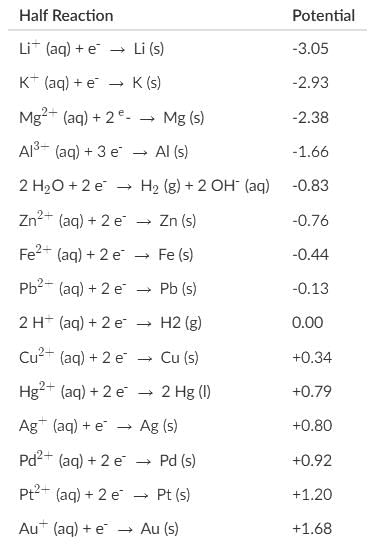 I. Aluminum
I. Aluminum
II. Palladium
III. Potassium
IV. Zinc- a)II only
- b)I and III
- c)II and IV
- d)I, III, and IV
Correct answer is option 'D'. Can you explain this answer?
Given the table of reduction potentials, which metals will displace hydrogen gas out of acid?

I. Aluminum
II. Palladium
III. Potassium
IV. Zinc
II. Palladium
III. Potassium
IV. Zinc
a)
II only
b)
I and III
c)
II and IV
d)
I, III, and IV

|
Orion Classes answered |
The key equation to look for is the one that shows acid reacting to become hydrogen gas, namely:
2H+ + 2e- → H2(g)
Let’s make this our reference potential. We have to look for metals with more negative reduction potentials or more positive oxidation potentials.
Since we already have our desired reduction half-reaction above, we have to look for more negative potentials than our reference. Any metal with more negative reduction potential will suffice from lithium down to lead.
Aluminum (Al), potassium (K), and zinc (Zn) fit the bill, and roman numerals I, III, and IV are correct.
Chemical oxidizing of water to produce O2 gas is an energy demanding reaction, done routinely by plants using the process called photosynthesis. By how many eV will it be uphill if the water oxidation reaction be carried out at pH = 0 versus at pH = 7.0:- a)0.41 eV
- b)–1.6 eV
- c)–0.41 eV
- d)None of these
Correct answer is option 'A'. Can you explain this answer?
Chemical oxidizing of water to produce O2 gas is an energy demanding reaction, done routinely by plants using the process called photosynthesis. By how many eV will it be uphill if the water oxidation reaction be carried out at pH = 0 versus at pH = 7.0:
a)
0.41 eV
b)
–1.6 eV
c)
–0.41 eV
d)
None of these

|
Maitri Sen answered |
Explanation:
The oxidation of water to produce O2 gas is an energy demanding reaction. The energy required to carry out this reaction can be calculated by considering the difference in the standard reduction potentials of the two half-reactions involved in the process.
The half-reactions involved in the process are:
2H2O(l) → O2(g) + 4H+(aq) + 4e- (oxidation half-reaction)
2H+(aq) + 2e- → H2(g) (reduction half-reaction)
The standard reduction potential for the reduction half-reaction is 0.00 V, while the standard reduction potential for the oxidation half-reaction is +1.23 V. The standard potential difference (ΔE°) between the two half-reactions is therefore:
ΔE° = E°(oxidation) - E°(reduction) = +1.23 V - 0.00 V = +1.23 V
This means that the oxidation of water to produce O2 gas is an uphill reaction, requiring an input of energy to proceed. The energy required can be calculated using the equation:
ΔG° = -nFE°
where ΔG° is the standard free energy change, n is the number of electrons transferred, F is the Faraday constant (96,485 C/mol), and E° is the standard reduction potential.
For the water oxidation reaction, n = 4 (since 4 electrons are transferred in the oxidation half-reaction) and ΔG° = +nFE° = +(4)(96,485 C/mol)(+1.23 V) = +472,311 J/mol = +0.47 kJ/mol.
Now, the pH of the solution also affects the standard potential of the half-reactions involved in the process. The standard reduction potential is pH-dependent and can be calculated using the Nernst equation:
E = E° - (RT/nF) ln([H+]/[H+])
where E is the reduction potential at the given pH, R is the gas constant, T is the temperature, n is the number of electrons transferred, F is the Faraday constant, [H+] is the hydrogen ion concentration, and [H+] is the standard hydrogen ion concentration.
At pH = 7.0, the hydrogen ion concentration is [H+] = 10^-7 M, and the standard reduction potential can be calculated as:
E = E° - (RT/nF) ln([H+]/[H+]) = 0.00 V - (0.0257 V/n) ln(10^-7/1) = 0.00 V - 0.0257 V = -0.026 V
At pH = 0, the hydrogen ion concentration is [H+] = 1 M, and the standard reduction potential can be calculated as:
E = E° - (RT/nF) ln([H+]/[H+]) = 0.00 V - (0.0257 V/n) ln(1/1) = 0.00 V - 0.0257 V = -0.026 V
The change in the standard reduction potential between pH = 7.0 and pH = 0 is therefore:
ΔE° = E°(pH=0) - E°(pH=7.0) =
The oxidation of water to produce O2 gas is an energy demanding reaction. The energy required to carry out this reaction can be calculated by considering the difference in the standard reduction potentials of the two half-reactions involved in the process.
The half-reactions involved in the process are:
2H2O(l) → O2(g) + 4H+(aq) + 4e- (oxidation half-reaction)
2H+(aq) + 2e- → H2(g) (reduction half-reaction)
The standard reduction potential for the reduction half-reaction is 0.00 V, while the standard reduction potential for the oxidation half-reaction is +1.23 V. The standard potential difference (ΔE°) between the two half-reactions is therefore:
ΔE° = E°(oxidation) - E°(reduction) = +1.23 V - 0.00 V = +1.23 V
This means that the oxidation of water to produce O2 gas is an uphill reaction, requiring an input of energy to proceed. The energy required can be calculated using the equation:
ΔG° = -nFE°
where ΔG° is the standard free energy change, n is the number of electrons transferred, F is the Faraday constant (96,485 C/mol), and E° is the standard reduction potential.
For the water oxidation reaction, n = 4 (since 4 electrons are transferred in the oxidation half-reaction) and ΔG° = +nFE° = +(4)(96,485 C/mol)(+1.23 V) = +472,311 J/mol = +0.47 kJ/mol.
Now, the pH of the solution also affects the standard potential of the half-reactions involved in the process. The standard reduction potential is pH-dependent and can be calculated using the Nernst equation:
E = E° - (RT/nF) ln([H+]/[H+])
where E is the reduction potential at the given pH, R is the gas constant, T is the temperature, n is the number of electrons transferred, F is the Faraday constant, [H+] is the hydrogen ion concentration, and [H+] is the standard hydrogen ion concentration.
At pH = 7.0, the hydrogen ion concentration is [H+] = 10^-7 M, and the standard reduction potential can be calculated as:
E = E° - (RT/nF) ln([H+]/[H+]) = 0.00 V - (0.0257 V/n) ln(10^-7/1) = 0.00 V - 0.0257 V = -0.026 V
At pH = 0, the hydrogen ion concentration is [H+] = 1 M, and the standard reduction potential can be calculated as:
E = E° - (RT/nF) ln([H+]/[H+]) = 0.00 V - (0.0257 V/n) ln(1/1) = 0.00 V - 0.0257 V = -0.026 V
The change in the standard reduction potential between pH = 7.0 and pH = 0 is therefore:
ΔE° = E°(pH=0) - E°(pH=7.0) =
The conductance of a solution of an electrolyte is same as that of its conductivity. The cell used can be said to have cell constant equal to:- a)1
- b)Zero
- c)100
- d)10
Correct answer is option 'A'. Can you explain this answer?
The conductance of a solution of an electrolyte is same as that of its conductivity. The cell used can be said to have cell constant equal to:
a)
1
b)
Zero
c)
100
d)
10

|
Lekshmi Deshpande answered |
Explanation:
The conductance of a solution refers to its ability to conduct electric current, and it is determined by the concentration of ions in the solution. The conductivity, on the other hand, is a measure of the ability of the solution to conduct electricity and is determined by the conductance and the cell constant.
Definition of Conductance:
Conductance is defined as the reciprocal of resistance and is denoted by the symbol G. It is a measure of the ease with which an electric current flows through a solution. The unit of conductance is siemens (S).
Definition of Conductivity:
Conductivity, denoted by the symbol κ (kappa), is a measure of the ability of a solution to conduct electric current. It is defined as the conductance of a solution of unit volume and unit length between two electrodes placed one unit apart. The unit of conductivity is siemens per meter (S/m).
Relationship between Conductance and Conductivity:
The conductance (G) of a solution is directly proportional to its conductivity (κ) and the cell constant (K). Mathematically, it can be represented as:
G = κ × K
Where:
G = Conductance
κ = Conductivity
K = Cell Constant
Therefore, the conductance of a solution is equal to the product of its conductivity and the cell constant.
Significance of Cell Constant:
The cell constant (K) is a proportionality constant that relates the conductance of a solution to its conductivity. It depends on the dimensions and geometry of the cell used for conductivity measurements. The cell constant is typically determined experimentally by calibrating the cell with a standard solution of known conductivity.
Conclusion:
In the given question, it is stated that the conductance of a solution is the same as its conductivity. Therefore, the cell constant can be said to be equal to 1. This means that the cell used for the conductivity measurement has a uniform geometry and dimensions, resulting in a cell constant of 1.
The conductance of a solution refers to its ability to conduct electric current, and it is determined by the concentration of ions in the solution. The conductivity, on the other hand, is a measure of the ability of the solution to conduct electricity and is determined by the conductance and the cell constant.
Definition of Conductance:
Conductance is defined as the reciprocal of resistance and is denoted by the symbol G. It is a measure of the ease with which an electric current flows through a solution. The unit of conductance is siemens (S).
Definition of Conductivity:
Conductivity, denoted by the symbol κ (kappa), is a measure of the ability of a solution to conduct electric current. It is defined as the conductance of a solution of unit volume and unit length between two electrodes placed one unit apart. The unit of conductivity is siemens per meter (S/m).
Relationship between Conductance and Conductivity:
The conductance (G) of a solution is directly proportional to its conductivity (κ) and the cell constant (K). Mathematically, it can be represented as:
G = κ × K
Where:
G = Conductance
κ = Conductivity
K = Cell Constant
Therefore, the conductance of a solution is equal to the product of its conductivity and the cell constant.
Significance of Cell Constant:
The cell constant (K) is a proportionality constant that relates the conductance of a solution to its conductivity. It depends on the dimensions and geometry of the cell used for conductivity measurements. The cell constant is typically determined experimentally by calibrating the cell with a standard solution of known conductivity.
Conclusion:
In the given question, it is stated that the conductance of a solution is the same as its conductivity. Therefore, the cell constant can be said to be equal to 1. This means that the cell used for the conductivity measurement has a uniform geometry and dimensions, resulting in a cell constant of 1.
What is the observation when the opposing external applied potential to an electrochemical cell is greater than the cell’s potential?- a)Only reduction reactions occur in the cell
- b)The electrochemical cell stops functioning
- c)Only oxidation reactions occur in the cell
- d)The electrochemical cell behaves like an electrolytic cell
Correct answer is option 'D'. Can you explain this answer?
What is the observation when the opposing external applied potential to an electrochemical cell is greater than the cell’s potential?
a)
Only reduction reactions occur in the cell
b)
The electrochemical cell stops functioning
c)
Only oxidation reactions occur in the cell
d)
The electrochemical cell behaves like an electrolytic cell

|
Edurev.iitjam answered |
In an electrochemical cell, when an opposing externally potential is applied and increased slowly, the reaction continues to take place.
- When the external potential is equal to the potential of the cell, the reaction stops.
- Once the externally applied potential is greater than the potential of the cell, the reaction goes in the opposite direction and the cell behaves like an electrolytic cell.
A current is passed through a Ga(NO3)3 for 1.5 hours, and after this time period the mass of metal produced was 6.3 grams. What is the current, in amperes, that is required to produce such an amount of gallium?- a)1.7 A
- b)5.0 A
- c)100 A
- d)300 A
Correct answer is option 'B'. Can you explain this answer?
A current is passed through a Ga(NO3)3 for 1.5 hours, and after this time period the mass of metal produced was 6.3 grams. What is the current, in amperes, that is required to produce such an amount of gallium?
a)
1.7 A
b)
5.0 A
c)
100 A
d)
300 A
|
|
Ellie Gonzales answered |
To determine the current required to produce 6.3 grams of gallium (Ga) in 1.5 hours, we can use Faraday's law of electrolysis.
The key formula for Faraday's law is:
M = (Q * Molar mass) / (n * F)
Where:
M is the mass of the substance produced (in grams)
Q is the total charge passed through the electrolyte (in Coulombs)
Molar mass is the molar mass of the substance (in grams per mole)
n is the number of moles of electrons required for the reaction
F is Faraday's constant (96,485 Coulombs per mole of electrons)
In this case, we are given that the mass produced is 6.3 grams and the time is 1.5 hours. We need to find the current (I) in amperes.
1. Calculate the total charge passed through the electrolyte.
We know that current (I) is equal to charge (Q) divided by time (t). Therefore, we can rearrange the formula to find the charge:
Q = I * t
Q = I * 1.5
2. Calculate the number of moles of gallium produced.
We can use the molar mass of gallium to convert the mass produced to moles:
n = M / Molar mass
n = 6.3 / (69.723 g/mol)
3. Calculate the current (I) using Faraday's law.
Substitute the values into the formula and solve for I:
M = (Q * Molar mass) / (n * F)
6.3 = (I * 1.5 * 69.723) / (n * 96,485)
I = (6.3 * n * 96,485) / (1.5 * 69.723)
4. Calculate the current in amperes.
Substitute the value of n and solve for I:
I = (6.3 * 0.0902 * 96,485) / (1.5 * 69.723)
I ≈ 5.0 A
Therefore, the current required to produce 6.3 grams of gallium in 1.5 hours is approximately 5.0 Amperes (A), which corresponds to option (B).
The key formula for Faraday's law is:
M = (Q * Molar mass) / (n * F)
Where:
M is the mass of the substance produced (in grams)
Q is the total charge passed through the electrolyte (in Coulombs)
Molar mass is the molar mass of the substance (in grams per mole)
n is the number of moles of electrons required for the reaction
F is Faraday's constant (96,485 Coulombs per mole of electrons)
In this case, we are given that the mass produced is 6.3 grams and the time is 1.5 hours. We need to find the current (I) in amperes.
1. Calculate the total charge passed through the electrolyte.
We know that current (I) is equal to charge (Q) divided by time (t). Therefore, we can rearrange the formula to find the charge:
Q = I * t
Q = I * 1.5
2. Calculate the number of moles of gallium produced.
We can use the molar mass of gallium to convert the mass produced to moles:
n = M / Molar mass
n = 6.3 / (69.723 g/mol)
3. Calculate the current (I) using Faraday's law.
Substitute the values into the formula and solve for I:
M = (Q * Molar mass) / (n * F)
6.3 = (I * 1.5 * 69.723) / (n * 96,485)
I = (6.3 * n * 96,485) / (1.5 * 69.723)
4. Calculate the current in amperes.
Substitute the value of n and solve for I:
I = (6.3 * 0.0902 * 96,485) / (1.5 * 69.723)
I ≈ 5.0 A
Therefore, the current required to produce 6.3 grams of gallium in 1.5 hours is approximately 5.0 Amperes (A), which corresponds to option (B).
The specific conductances of four electrolytes in ohm−1cm−1 are given below. Which one offers higher resistance to passage of electric current?- a)9.2 × 10−9
- b)7.0 × 10−5
- c)6.0 × 10−7
- d)4.0 × 10−8
Correct answer is option 'A'. Can you explain this answer?
The specific conductances of four electrolytes in ohm−1cm−1 are given below. Which one offers higher resistance to passage of electric current?
a)
9.2 × 10−9
b)
7.0 × 10−5
c)
6.0 × 10−7
d)
4.0 × 10−8

|
Edurev.iitjam answered |
Specific conductance = Cell constant/Resistance
∴ Specific conductance ∝ 1/Resistance
∴ The one with the lowest resistance (order 10-9) will have the highest specific conductance.
Hence, option A is correct.
∴ Specific conductance ∝ 1/Resistance
∴ The one with the lowest resistance (order 10-9) will have the highest specific conductance.
Hence, option A is correct.
The time required to coat a metal surface of 80 cm2 with 5 × 10–3 cm thick layer of silver (density 1.05 g cm–3) with the passage of 3A current through a silver nitrate solution is:- a)115 sec
- b)125 sec
- c)135 sec
- d)145 sec
Correct answer is option 'B'. Can you explain this answer?
The time required to coat a metal surface of 80 cm2 with 5 × 10–3 cm thick layer of silver (density 1.05 g cm–3) with the passage of 3A current through a silver nitrate solution is:
a)
115 sec
b)
125 sec
c)
135 sec
d)
145 sec

|
Ciel Knowledge answered |
- First, calculate the volume of the silver layer: Volume = Area x Thickness = 80 cm² x (5 x 10⁻³ cm) = 0.4 cm³.
- Next, determine the mass using the density: Mass = Volume x Density = 0.4 cm³ x 1.05 g/cm³ = 0.42 g.
- Convert mass to moles by dividing by the atomic mass of silver (approximately 108 g/mol): Moles = 0.42 g / 108 g/mol ≈ 0.00389 mol.
- According to Faraday's laws, the total charge required is given by Charge = Moles x Faraday's Constant (≈ 96500 coulombs/mol) = 0.00389 mol x 96500 C/mol ≈ 375 C.
- Finally, the time required is Time = Charge / Current = 375 C / 3 A = 125 sec.
Consider the following electrochemical cell, from which current is drawn through an external resistor of 10 Ohms. During this process, the concentration of CuSO4 in the left and the right halfcells were measured, and the value of  was calculated. From the init ial value of K = 10, predict the value of K after a very long time when the cell stopped giving any current.
was calculated. From the init ial value of K = 10, predict the value of K after a very long time when the cell stopped giving any current.
- a)An exact value cannot be predicted since CuSO4 so lutions of such high concentrations, as used above, would not behave ideally.
- b)K ≈ 0.1
- c)K = 1.0
- d)K will be very small, possibly < 0.00001.
Correct answer is option 'A'. Can you explain this answer?
Consider the following electrochemical cell, from which current is drawn through an external resistor of 10 Ohms. During this process, the concentration of CuSO4 in the left and the right halfcells were measured, and the value of  was calculated. From the init ial value of K = 10, predict the value of K after a very long time when the cell stopped giving any current.
was calculated. From the init ial value of K = 10, predict the value of K after a very long time when the cell stopped giving any current.
a)
An exact value cannot be predicted since CuSO4 so lutions of such high concentrations, as used above, would not behave ideally.
b)
K ≈ 0.1
c)
K = 1.0
d)
K will be very small, possibly < 0.00001.

|
Saran Vishnu answered |
B
Conductometric titration curve of an equimolar mixture of HCl and HCN with NaOH (aq) can be given as- a)
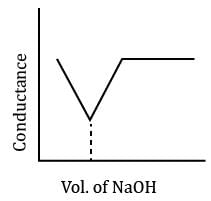
- b)
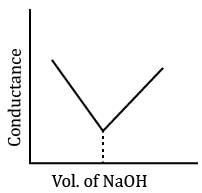
- c)
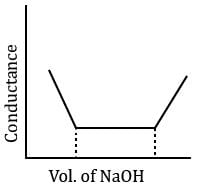
- d)
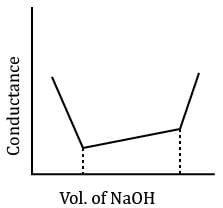
Correct answer is option 'D'. Can you explain this answer?
Conductometric titration curve of an equimolar mixture of HCl and HCN with NaOH (aq) can be given as
a)

b)

c)

d)


|
Edurev.iitjam answered |
The titration is an example of titration of mixture of acids against strong base (NaOH).
When mixture of acid is titrated with NaOH, strong acid will react first followed by weak acid.
Here, HCl will react with NaOH in the start and get neutralised.
The neutralised reaction is,
HCl + NaOH → NaCl + H2O
During this reaction, the conductance of the solution gradually decreases due to the removal of H+ ions of highly ionised HCl to form unionised water.
This will be the first part of the graph.
When HCl is finished HCN starts reacting with NaOH. Here, the neutralisation reaction is
HCN + NaOH → NaCN + H2O
HCN + NaOH → NaCN + H2O
During the neutralisation of weak acid the conductance increases marginally due to the salts (NaCN) produced which will be the second part of graph.
After the equivalence point, the increase in conductance is appreciable due to the added OH− ions.
Thus, the conductance will decrease steeply and then increase marginally and again increase steeply.
Thus, option (d) is correct.
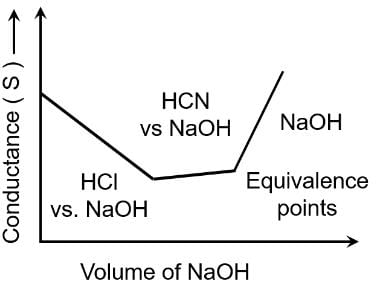
Thus, option (d) is correct.

Which of the following is true regarding a galvanic cell?- a)It converts electrical energy into chemical energy.
- b)It requires an external electrical power source.
- c)The anode is the site of reduction.
- d)The cathode is the site of oxidation.
Correct answer is option 'A'. Can you explain this answer?
Which of the following is true regarding a galvanic cell?
a)
It converts electrical energy into chemical energy.
b)
It requires an external electrical power source.
c)
The anode is the site of reduction.
d)
The cathode is the site of oxidation.
|
|
Ayesha Joshi answered |
A galvanic cell, also known as a voltaic cell, converts chemical energy into electrical energy. It does not require an external electrical power source as the redox reaction occurring within the cell generates the electrical energy. The anode is the site of oxidation, where electrons are lost, while the cathode is the site of reduction, where electrons are gained.
The salt bridge is essential in maintaining electrical neutrality in a Daniell cell. In the absence of a salt bridge, the two compartments will accumulate the opposite charges and prevent further reaction. For the salt bridge to function properly, there must be an appropriate electrolyte. Which of the following statements most accurately explains whether an electrolyte is appropriate for the salt bridge in the following electrochemical cell?
- a)K2SO4 is not appropriate because polyatomic ions such as the sulfate ion will oxidize more easily than water.
- b)KOH is not a good choice because potassium has a very positive reduction potential.
- c)CuS is a good choice because neither the cation and anion will react with the ions in the compartments.
- d)KCl is not appropriate because this compound will react with the ions in the compartments.
Correct answer is option 'D'. Can you explain this answer?
The salt bridge is essential in maintaining electrical neutrality in a Daniell cell. In the absence of a salt bridge, the two compartments will accumulate the opposite charges and prevent further reaction. For the salt bridge to function properly, there must be an appropriate electrolyte. Which of the following statements most accurately explains whether an electrolyte is appropriate for the salt bridge in the following electrochemical cell?

a)
K2SO4 is not appropriate because polyatomic ions such as the sulfate ion will oxidize more easily than water.
b)
KOH is not a good choice because potassium has a very positive reduction potential.
c)
CuS is a good choice because neither the cation and anion will react with the ions in the compartments.
d)
KCl is not appropriate because this compound will react with the ions in the compartments.
|
|
Ayesha Joshi answered |
KOH is not appropriate since hydroxide would migrate towards the anode and react with the silver ion in solution.
CuS is not appropriate since it is insoluble in water, so no ions would be available to migrate to the anode or cathode compartment to balance the charge.
K2SO4 is a good choice because it is soluble in water, and neither the cation not the anion will react with the ions in the anode or cathode compartment.
KCl would be a good choice normally because it does not react with any of the chemicals used in the cell, and the anion and cation have similar conductivity, and hence similar migratory speed. In this case, since one of the ions is silver and silver chloride is insoluble, a KCl bridge is not appropriate.
A 19th century iron bridge is protected from corrosion by connecting it to a block of metal (sacrificial anode), which is replaced annually. The corrosion of iron, represented by the chemical equation: Which of the following metals is best suited as sacrificial anode:
Which of the following metals is best suited as sacrificial anode:- a)

- b)

- c)

- d)

Correct answer is option 'D'. Can you explain this answer?
A 19th century iron bridge is protected from corrosion by connecting it to a block of metal (sacrificial anode), which is replaced annually. The corrosion of iron, represented by the chemical equation:
Which of the following metals is best suited as sacrificial anode:
a)
b)
c)
d)

|
Yash Kumar answered |
In Corrison , Fe is getting oxidized so a metal with low reduction potential is best suited for sacrificial anode that's why Mg.
Chapter doubts & questions for Electrochemistry (GC) - MCAT Chemical and Physical Foundations 2025 is part of MCAT exam preparation. The chapters have been prepared according to the MCAT exam syllabus. The Chapter doubts & questions, notes, tests & MCQs are made for MCAT 2025 Exam. Find important definitions, questions, notes, meanings, examples, exercises, MCQs and online tests here.
Chapter doubts & questions of Electrochemistry (GC) - MCAT Chemical and Physical Foundations in English & Hindi are available as part of MCAT exam.
Download more important topics, notes, lectures and mock test series for MCAT Exam by signing up for free.
MCAT Chemical and Physical Foundations
336 videos|223 docs|109 tests
|

Contact Support
Our team is online on weekdays between 10 AM - 7 PM
Typical reply within 3 hours
|
Free Exam Preparation
at your Fingertips!
Access Free Study Material - Test Series, Structured Courses, Free Videos & Study Notes and Prepare for Your Exam With Ease

 Join the 10M+ students on EduRev
Join the 10M+ students on EduRev
|

|
Create your account for free
OR
Forgot Password
OR
Signup to see your scores
go up within 7 days!
Access 1000+ FREE Docs, Videos and Tests
Takes less than 10 seconds to signup

